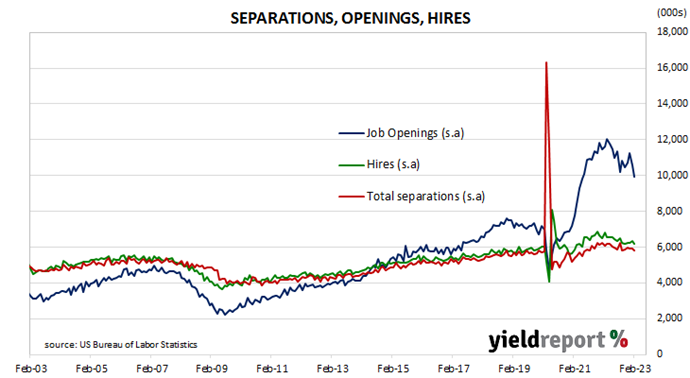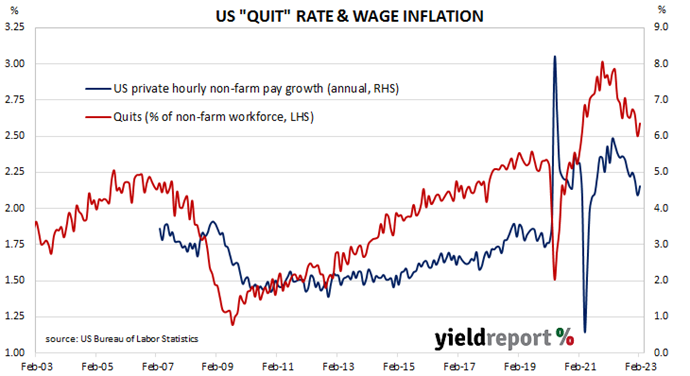Summary: US quit rate rises to 2.6% in February; US yields down; expectations of lower rates firm; quits up, openings, separations down; NAB: confirms softening in US labour demand.
The number of US employees who quit their jobs as a percentage of total employment increased slowly but steadily after the GFC. It peaked in March 2019 and then tracked sideways until virus containment measures were introduced in March 2020. The quit rate then plummeted as alternative employment opportunities rapidly dried up. Following the easing of US pandemic restrictions, it proceeded to recover back to its pre-pandemic rate in the third quarter of 2020 and trended higher through 2021 before easing through 2022.
Figures released as part of the latest Job Openings and Labor Turnover Survey (JOLTS) report show the quit rate increased in February. 2.6% of the non-farm workforce left their jobs voluntarily, up from 2.5% in January. Quits in the month rose by 146,000 while an additional 311,000 people were employed in non-farm sectors.
US Treasury yields moved lower, especially at the short end. By the close of business, the 2-year yield had shed 13bps to 3.84%, the 10-year yield had lost 6bps to 3.35% while the 30-year yields finished 4bps lower at 3.60%.
In terms of US Fed policy, expectations of cuts to the federal funds rate hardened. At the close of business, contracts implied the effective federal funds rate would average 4.93% in May, 10bps higher than the current spot rate, and then decline to an average of 4.905% in June. July futures contracts implied a 4.855% average effective federal funds rate while April 2024 contracts implied 3.715%.
The rise in total quits was led by 115,000 more resignations in the “Professional and business services” sector while the “Finance and insurance” sector experienced the largest loss, decreasing by 39,000. Overall, the total number of quits for the month rose from January’s revised figure of 3.878 million to 4.024 million.
Total vacancies at the end of February decreased by 0.632 million, or 6.0%, from January’s revised figure of 10.563 million to 9.931 million. The fall was driven by a 278,000 drop in the “Professional and business services” sector while the “Construction” sector experienced the single largest increase, rising by 129,000. Overall, 9 out of 18 sectors experienced fewer job openings than in the previous month.
“The decline in job openings confirms the softening in US labour demand evident in the Indeed job postings data,” said NAB Senior FX Strategist (Markets) Rodrigo Catril.. “The February JOLT figures also confirm US labour demand is trending down with the NFIB survey suggesting further declines should be expected over coming months.”
Total separations decreased by 80,000, or 1.4%, from January’s revised figure of 5.900 million to 5.820 million. The fall was led by the “Professional and business services” sector where there were 66,000 fewer separations than in January. Separations decreased in 9 of the 18 sectors.

The “quit” rate time series produced by the JOLTS report is a leading indicator of US hourly pay. As wages account for around 55% of a product’s or service’s price in the US, wage inflation and overall inflation rates tend to be closely related. Former Federal Reserve chief and current Treasury Secretary Janet Yellen was known to pay close attention to it.


